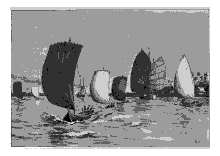When pursued by the boats of the
Royal Navy, they would make good their escape by just
bumping over a friendly bar where their pursuers could
not follow them, and then turning aside up some of the
innumerable creeks that intersect the mangrove swamps
near the river mouths. Hence came the necessity for
shallow draught and small tonnage.
A second factor, scarcely less potent,
so far as the west coast of the Peninsula from Penang to
Singapore is concerned, has been the variable character
of the light breezes prevailing in the Straits of
Malacca.
The monsoon currents of the
neighbouring seas do not blow with any regularity or
force owing to the protection afforded by the island of
Sumatra on the south-west and the Peninsula on the east;
and the usual light winds are varied only by occasional
south-westerly squalls of great violence but short
duration known as 'Sumatras.'
SINGORA FISHING CANOE
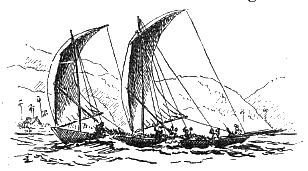
A third factor was the strength of the
tides, which, on the Selangor coastline, have a rise and
fall of twenty feet or more. The lot of the
sailing-vessel in this neighbourhood is thus precarious;
racing tides and baffling winds and calms make progress
very slow. Hence mechanical propulsion by oars or paddles
was the first necessity of the old-time Malay seaman in
the Straits as with the early sailors of the
Mediterranean; sails were merely an occasional
convenience. The Malay soon found that a long light
craft, having plenty of accommodation along its sides for
paddlers, was by far the best adapted to the navigation
of these waters and, moreover, had the sailing-vessel at
its mercy nine times out of ten--a very pleasing feature
in the eyes of the Malay at the time when the Straits of
Malacca served as the high-road for all the sailing
tonnage of the Eastern trade. Moreover, the lack of
freeboard suitable for manual propulsion was not a
serious danger in a locality where heavy weather is so
little known. Hence it came about that the long 'canoe'
form of craft established itself as the most suitable
type and that not only as was natural for the river
navigation of the interior, but also for the estuaries
and the more open waters of the Straits. Steam and the
growth of the British power in the Straits have combined
to make impossible the old buccaneering pursuits dear to
the heart of the Malay sailor, and he is now constrained
to ship as a fo'c's'le hand in Penang or Singapore
steamers, or make sailing voyages up and down the coasts
as a commonplace unromantic trader or peaceful fisherman,
with few chances of plunder, and even less opportunity
for using his kriss.
The foregoing remarks are not,
however, entirely applicable to the east coast of the
Peninsula, where during the prevalence of the north-east
monsoon in the China Sea, strong gales with heavy sea and
violent rain blow havoc upon the unprotected coastline.
At first sight, then, we might have expected to find some
powerful sea-keeping boats on this coast, but, in fact,
we find practically the same types as on the sheltered
waters of the Malacca Straits. The explanation is easy.
During the prevalence of the onshore monsoon, the bars at
the entrance to the rivers, which form the only ports,
are a whirling mass of breaking seas, through which only
during rare lulls in the weather can any vessel pass with
safety. To such an extent indeed is this the case, that
the north-east monsoon is called by the Malays 'Musim
Tutop Kuala,' or the 'shut-port (i.e. close)
season.'
SINGAPORE
SAMPAN
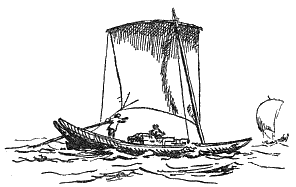 From
the shelving beaches thrown up by the monsoon it is, of
course, impossible to launch a boat. Hence from October
or November to February or later, according to the
strength of the weather, the whole coast is shut up so
far as local navigation is concerned. An occasional
high-sided Chinese junk will now and then venture along
the coast, but communication in most cases becomes easier
across the Peninsula, and the men of Patani and Singora
find it simpler to cross overland to Kedah to reach the
west coast than to attempt to get out across the
dangerous bars and through the heavy sea raging on the
eastern coast.
From
the shelving beaches thrown up by the monsoon it is, of
course, impossible to launch a boat. Hence from October
or November to February or later, according to the
strength of the weather, the whole coast is shut up so
far as local navigation is concerned. An occasional
high-sided Chinese junk will now and then venture along
the coast, but communication in most cases becomes easier
across the Peninsula, and the men of Patani and Singora
find it simpler to cross overland to Kedah to reach the
west coast than to attempt to get out across the
dangerous bars and through the heavy sea raging on the
eastern coast.
During the open season the weather is
not unlike that in the Straits, bringing light sea and
land breezes varied by occasional squalls. Then the Malay
fishermen run their long canoes down the beach and put to
sea again, and the traders creep out with new mat-sails
to resume their coasting voyages.
WITH FAIR MONSOON
FROM A SKETCH IN THE GULF OF SIAM
Owing to lack of ports free from
shallow bars large displacement is impossible, and for
the fishermen light canoe-like craft are preferred, as
they launch easily from the beach and can be paddled at
high speeds to come up with fish. Hence deep-bodied boats
are again generally absent on this coast, and as the
centreboard and leeboard are not known the paddle retains
its importance for working to windward. It must be added,
however, that for some trades, involving long voyages and
calls at deepwater ports, the advantages of big-bodied
craft are fully recognised by the Peninsular Malays, and
that between Singapore and Siamese ports, for instance,
fine vessels of two hundred tons, built on European
lines, are frequently to be met with. They are rather
nondescript craft, often with overhanging clipper-stems
and a superabundance of deck-houses. The masts are
generally very light and crooked-grown spars; the rigging
and gear aloft make up in quantity what is lacking in
quality.
EAST COAST TRADER
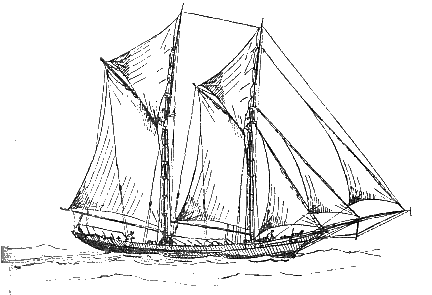
They are generally rigged with two nearly
equal-sized masts and bowsprit on which from one to three
jibs are set. The mainsail and foresail are either
Chinese lugs or on the European fore-and-aft plan, the
gaff being a standing spar controlled by vangs. The sail
is set by hauling out along it and taken in by brails to
the mast, and long topmasts with short double-spar
crosstrees and jib-headed top-sails are used. The sails
are of light material when they are not, as in the case
of regular Chinese or Malay lugs, made of matting, and
they seldom set very flat.
The true Malay sail, however, is
nothing more than an adaptation of the original and
primitive square-cut sail of the early navigators, and
this sail is used still in the majority of the Malay
fishing-craft and small traders, matting being the
material preferred. It is used in its most typical form
by the primitive Orang Laut on the west coast, north of
latitude seven.
ORANG LAUT BOAT, JUNKSEYLON
These primitive folk have practically
no homes but the kadjang coverings of their boats, which
they moor in snug anchorages among the islands. The
penjajaps, the traders of the more civilised Malays on
the east coast, also use this sail. A boom along the foot
is almost as necessary as a yard along the head. The
Malays, by the simple expedient of tilting the sail
forward so as to bring the tack right to the deck, have
long converted this square-cut sail into what is
practically a lugsail, the most powerful of lifting sails
on a wind. The dipping lug is set taut along the luff by
a spar bowline fitting in a cringle, the lower end of
which comes to the deck abaft the mast, as was the custom
in the old Scotch skaffies. The yard being too light to
stand alone by the wind, is invariably controlled by a
vang. The unhandiness of the dipping lug in tacking is
felt to the full with this sail owing to the stiffness
and weight given to it by the material of which it is
made and the boom along the foot, and the operation of
lowering and shifting sail is such a long one that the
anchor is often thrown over while the manoeuvre is gone
through with the two big sails of the
penjajap.
AT ANCHOR
FROM A SKETCH OFF LAKAWN
The devotion of the Malays to
top-hamper in the shape of raised deck-houses and
outrigged super-structures over the bow and stern is
shared with many other Eastern races, and is, no doubt,
largely owing to lack of body in their craft. In boats
with sharp and fine lines the cargo, whether of fish or
merchandise, has often to lie high, and consequently all
the accommodation for the crew is high up, and every foot
of extra space which can be built on in this manner is so
much added to their comfort and to convenience in working
the vessel. The galleries built out over the bows of the
larger craft, both of Malays and Chinese, are used for
working and storing the anchors, just as was the case in
the vessels of the classical and mediaeval seamen who
used the fore-galleries for the storage of their anchors;
and in boats which are often so lean about the quarters,
the little stern galleries and rails add greatly to the
comfort and safety of the steersman and of men handling
the mainsail.
MALAY PENJAJAP SINGORA HARBOR
Even in the smallest canoes, which
most of us would think crank under any circumstances,
there is generally in the East a grating (or lattice)
forming a raised floor, within an inch or two of the top
of the gunwale, upon which the crew is accommodated. It
can certainly not be claimed that such an arrangement
conduces to stability; yet such good watermen are these
warm-water sailors, and the Malays in particular, that
even long coasting voyages are undertaken in such craft
without any apparent anxiety as to the result.
The penjajap on the east coast is
often a rather unsuccessful imitation of European build,
with transom-stern half concealed by the overhanging
stern galleries. There is generally plenty of show; but
the boat is very wall-sided, with insufficient beam,
which facts combine to spoil her appearance on a close
inspection, although she looks smart enough a little
distance off.
MALAY PENJAJAP GOOSE-WINGED
The writer has seen these boats nearly
on their beams' ends when caught by a heavy squall at
anchor, though with no thing but their slender masts
aloft, a fact largely caused by the want of under-water
body in the hull, and the amount of top-hamper by way of
accommodation on deck. A bundle of bamboos along under
each gunwale frequently adds some much-needed stability
of the kind supplied by the outrigger, and provides a
store from which to renew broken spars. Yet crank as
these craft seem, the Malays manage to make their way for
long distances in them with very few
accidents.
No fact could form more conclusive
evidence of their pluck and skill.
The Malay, like a true seaman, takes a
great pride in his vessel, and if his ideas of ornamental
decoration do not always accord with those of the West,
he has, at all events, never been guilty of producing
such scarecrows of the seas as many of the tramp steamers
at this moment lying in the port of London. In rigging,
as already hinted, he is partial to slender, lofty masts,
and if his vessel is large enough, he indulges in two
masts of nearly equal height, to which is generally given
a very smart rake forward.
RUNNING INTO SINGORA
TRANSOM-STERNED PENJAJAP
Under Chinese sails, the advantages of
which over the dipping lug have been recognised by many
on the east coast, the Malay may be distinguished from
the Chinaman at sea, when yet hull down, by the equal
size of the big sails, and the invariable absence of any
mizen. The hull is also low and long, with no
many-storied castle aft, but merely a kadjang, or thatch
awning, over the raised, overhanging poop, or a simple
dandan, or gallery. There is something of the yachtsman
in the Malay, and he is much addicted to graceful little
vanities about the stem-head and stern-post of his small
boats; and so greatly does he hold the figurehead in
estimation, that a class of boat is often named after the
form given to the stem-head. European influence may now
be seen at work, to a greater or less degree, in almost
every class of rig in the ports of the Peninsula; but the
Malay, more than any other Oriental, has adopted the jib,
or three-corner staysail.
MALAY,
EAST COAST
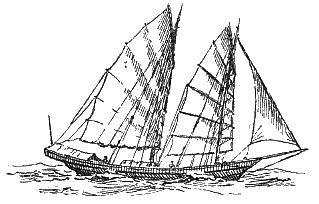 This
essentially modern product of Western Europe he uses not
only in the large traders already referred to, but also
in the kolek, or 'sea-canoe' of Singapore, in which also
the old Malay lug has been altogether discarded,
especially for racing purposes, in favour of the
spritsail. The staysail is recognised as the most
convenient form of head-sail to prevent excessive
griping, and does not involve the disadvantages of the
weight of a mast right in the eyes of the
boat.
This
essentially modern product of Western Europe he uses not
only in the large traders already referred to, but also
in the kolek, or 'sea-canoe' of Singapore, in which also
the old Malay lug has been altogether discarded,
especially for racing purposes, in favour of the
spritsail. The staysail is recognised as the most
convenient form of head-sail to prevent excessive
griping, and does not involve the disadvantages of the
weight of a mast right in the eyes of the
boat.
It will thus be seen that, from a
variety of causes, with which the physical geography and
the meteorology of the Peninsula have much to do, the
canoe shape, the canoe idea predominates in most of the
boats of the Malay Peninsula. It may, in fact, be said
that the maritime enterprise of its inhabitants obviously
commenced with the canoe and continued with the canoe,
and that its highest form of development has resulted in
a craft of larger dimensions, which yet in all essential
particulars still remains -- a canoe.
KOLEK, SINGAPORE STRAIT
The nomenclature employed by the
Malays for their boats appears to the traveller at first
to be unnecessarily intricate. Closer attention, however,
soon shows that the name, as has indeed been already
suggested, is very rarely derived from the rig, as is so
much the case in Europe, but rather from distinctions,
which often seem to the stranger to be comparatively
insignificant, in the hulls or build. Nearly every
water-side settlement of any importance having developed
its own ideas of ornamentation or of construction, it is
not to be wondered at that boats which might well be
classed under one head, as far as all essential
particulars are concerned, yet come under the observation
of the traveller under widely different names, differing
often merely with the locality of their origin. For
instance, a number of otherwise very similar boats are
named --
(a) simply after the form of
figurehead, to the frequency of which reference has
already been made, e.g. the hornbill boat, *1* the
crocodile boat ; *2*
or
(b) from some peculiarity in
construction, e.g. the Patani 'half-decked' *3* boat
(literally, boat with decked fore-part), or the
'civet-fence' *4* boat, which is nothing but a form of
the type generally known as penjajap, to which a
peculiarly ornamental bulwark or rail is
given.
SINGAPORE FISHING CANOE
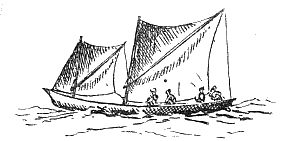 A
large number of boats, as might be expected, are
distinguished by the use for which they are built, e.g.
the 'boat for going up-stream,' *5* and various types of
fishing boat ; *6* others are of purely local
significance, e.g. 'banting' (an Achinese type), while
several appear to be derived from European names, e.g.
'skonar' (schooner), and 'pinis' (pinnace), and perhaps
'kichi' (ketch), 'skuchi' (scotchy), and 'katar' '
(cutter).
A
large number of boats, as might be expected, are
distinguished by the use for which they are built, e.g.
the 'boat for going up-stream,' *5* and various types of
fishing boat ; *6* others are of purely local
significance, e.g. 'banting' (an Achinese type), while
several appear to be derived from European names, e.g.
'skonar' (schooner), and 'pinis' (pinnace), and perhaps
'kichi' (ketch), 'skuchi' (scotchy), and 'katar' '
(cutter).
|
*1* 'Prahu Enggang'
|
*2* 'Prahu Buaya'
|
|
*3* 'Katop Luan'
|
*4* 'Pagar Tenggalong'
|
|
*5* 'Prahu Pemudik'; from 'mudik,' to go
upstream.
|
*6* 'Prahu ikan,' or 'per-ikan' ; from
'Ikan,' fish.
|
It is noticeable that, in most of
their larger boats, the Malays have adopted the
comparatively modern method of slinging the rudder by
metal fastenings on the stern-post, known afloat as
'gudgeons' and 'pintles.'
MALAY TYPE, SINGORA
In many of their dug-out canoes, in
the kolek and some of the non-European types of
fishing-boats *1* of Selangor and the east coast, for
instance, the rudder consists of the simple paddle held
on the quarter, or a paddle-shaped rudder slung at the
head on a stout upright, and held at the neck by a rattan
lashing. This, as already pointed out, is the earliest
and simplest form of rudder known to man. It was that
used, as noted elsewhere, in the ships of the earliest
navigators of the Mediterranean of whom we have record,
*2* and it remained, with slight modifications, as the
usual steering contrivance of the Egyptians, of the
Greeks and Romans, and of the Danes and Saxons and
Normans, down to mediaeval times.
*1* e.g. the kakap jeram.
*2* e.g. the records of craft in Egypt so steered from
the time of the third dynasty (about 6000 BC), mentioned
above.
It is much used in some of the craft
of the northern portion of the Gulf of Siam, and it may
be rioted that this form of rudder is always used on the
lee quarter, if, as is usual, the boat carries a weather
helm, this position giving far greater power and deeper
immersion.
The Malays do not use oars to a great
extent, except with the bigger-decked vessels. These oars
are somewhat heavy about the loom, and have often
sharp-pointed blades, shaped rather like a broad angular
spear-head. They are generally worked in a rattan grommet
to a sharp, quick stroke, any other kind of stroke being
impossible owing to the friction in the grommet and the
shortness of the oar. The 'standing up and pushing'
('salmon-stroke' or 'sculling') position, common with the
Siamese and Chinese and in the Mediterranean, is, on the
whole, rarely adopted by the Malays. In the smaller
craft, with low freeboard, the paddle is used, the blades
in some localities having the same angular
spear-shape.
Boat-building
The Malays usually follow the general
Indo-Chinese method of construction in the first stages,
at all events, of their smaller boats.
A selected tree is laboriously
hollowed out by the adze until the sides are sufficiently
thinned to open out under pressure and the judicious
application of heat by a slow-burning ember fire beneath
the bottom. The fore and aft ends are roughly modelled
with the adze. Before proceeding further, the hull is at
this stage frequently soaked for some days in the water.
In many parts of Siam and Burma the presence of a
monastery can be almost certainly predicted by the little
fleet of hewn modelled hulls lying sunk beside a
landing-place, a sure sign of the boat-building
propensities of the brethren of the yellow robe close by.
When sufficiently soaked, the opening-out process
begins.
Various methods are used for the
purpose of opening out the dug-out. In some cases water
is placed inside the dug-out hull, and hot embers are
placed upon the ground underneath it, and kept at the
required temperature until the sides have opened out
sufficiently to take ribs, knees, and cross-pieces. The
sides, in falling out, come down to the level of bow and
stern, and your up-river canoe is now
complete.
Another method of opening the dug-out
hull is often used. To the perpendiculars on each side
cross-pieces are securely lashed under the hull. A
similar number of cross-pieces are placed above the hull,
over the lower ones, and connected by a strong double
rattan rope. Through these rattans hardwood levers or
handles are placed to give a purchase, and are then
twisted round and round bringing the ends of the
cross-pieces together. This pressure is kept constant
while water and hot embers are applied, as
necessary.
Two dug-outs may sometimes be seen
being cut from one log; the inner and smaller one is
worked out by the driving of stout wedges. In order to
facilitate the heavy work of driving home these wedges, a
low scaffolding is erected alongside one of the canoes
for the wedger to stand upon, and the log itself is
turned over till it lies at a convenient angle, by means
of a lever placed underneath it, the end of the lever
being raised by a rope made fast to a windlass. Sometimes
a simple floor or keel-piece is used, on which the boat
is subsequently built up. In this case stem and stern
pieces will be worked in. The sides are rabbeted into the
floor-piece, and the upper strakes built on as in an
ordinary carvel-built boat. The simple dug-out form
having been obtained, the upper strakes can be built on,
the ribs being carried up to receive them. For this
purpose the planks are bent by various ingenious
applications of levers and hot embers. Many clever
devices are used by the Malays for getting the necessary
power, and the boat-builder has many arrangements of
stout upright pegs about his shop or in his compound, set
to all possible curves and angles which he is wont to
use.
In the inland sea of Singora many
dug-outs may be seen, built up with strake on strake, in
the most unblushing way, without any attempt to hide the
roughest method of boat-building perhaps to be seen
anywhere. No attempt is made to work in stem and stern
posts. The ends are blocked across a foot or two inside
the end of the boat's nose or tail, if one may use the
expression, thus forming thwartship water-tight
bulkheads. The two or three strakes, often variously
coloured, are built on, and the topmost one is utilised
to give a finish to the whole, by being extended and
turned up forward, and carried out to form a steersman's
staging some way aft. The almost submerged noses of these
boats, which are really more Siamese than Malay in type,
have generally a most pathetic expression of
protest.
LAKE BOAT, SINGORA
It reminded my imaginative Siamese of
the wistful look on the face of a puppy when thrown into
the water for the first time. They draw very little
water, and are used all over the lake, being able to
navigate the shallows which now form so large a portion
of it. They are usually rigged, not with the Malay lug,
but the Siamese high-pointed standing lug, a far handier
and handsomer sail. For these the very light yellow
matting is used, which is almost universal in the upper
portion of the Gulf of Siam.
There is a further method of warping
planks by aid of a fire, by which, when the planks are
ready to go on as upper strakes, they are fixed in
position, and built up upon the dug-out keel and floor
portion of the boat, which has already been opened out to
the required extent. These strakes, as they are put on,
are held in position by a system of bamboo ties, and
secured by rattan lashings.
KAKAP JERAM, SELANGOR
The last stages of the Malay boat
differ with the district. In many cases a beautiful
finish is given to the fittings, and a shining polish to
the under-water portion of the hull At this stage half
the village may be found at the boat-builder's, polishing
or criticizing with much energy and
enthusiasm.
Peninsular Types
Among the more noticeable types of
boat may be mentioned the Kakap Jeram. This is a typical
Malay fishing-boat of the Selangor coast. Kakap means
'spy' or 'scout,' or 'look-out,' and Jeram is the name of
a big fishing-village in the Kuala Selangor district (of
Selangor), from which this boat took its name of the
Jeram scouter. The rig is practically the same as that of
the nadir. The sketch shows the figure head and
ornamented stern-post, and the long paddle rudder already
described. The gratings on which the crew are
accommodated are shown, and along each side forming the
gunwale may be seen a wash-strake formed of strong lacing
of split bamboo strips, stoutly sewn together with bamboo
withies, and filled in with palm-leaf, the whole held in
position by lashings to knees brought up from the boat's
ribs. This is a very usual form of wash-strake in Malay
boats and is much used by the Orang Laut, or sea-dwelling
Malays of the west coast. It is strong, light, and
effective. It is given considerable flare at each
quarter. The equivalent of the lumber irons used in
European fishing-craft is provided by loops of rattan on
the starboard side, and here the punt-poles and other
spars are stowed. Forward will be noticed a peculiar form
of bits, stretching athwartships, used for winding the
cable upon, as well as bitting it ; *1* it is used by the
Siamese as well as by the Malays.
The kolek *2* -- literally the
'rocker' or wobbler, from its crank build -- is a very
common form of small canoe. The term sampan, a word of
apparently Chinese origin, which is given generally to
any small, especially Chinese, boat, is also frequently
applied to these canoes. The kolek is the usual form of
small sea-fishing canoe, the stem and stern posts are
generally high and pointed, with some decorative
paint-work or other ornamentation.
*1* Dimensions : 13 feet by 7 feet by 3 feet; 1 foot
freeboard; capacity, 2 koy; crew of 3; length of mast, 23
feet; material, meranti.
*2* Klinkert says : 'The small variety for one person
only; but big ones hold ten or more
persons.'
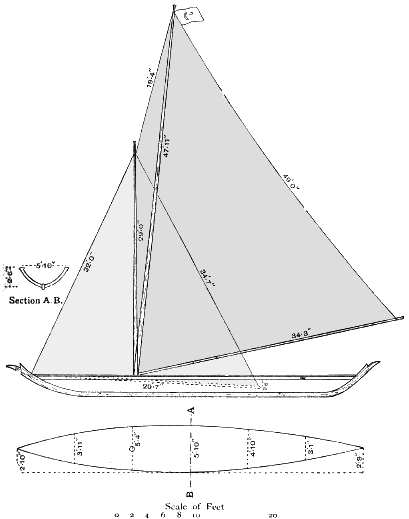
MALAY KOLEK OR SEA-CANOE
SINGAPORE RACING TYPE
By kind permission of the Editor of the
Yachtsman
It is generally carvel-built, with a
shapely hull and prettily rounded forefoot; but there is
very little bilge, and consequently small stability,
which, combined with the low canoe-like freeboard, makes
these boats somewhat tricky to the novice. The peculiar
'crabs' eyes' are frequently to be seen in these boats.
They carry single or double lugsails, according to
length. Ill the former case, the tack of the sail is
usually belayed at the mast, so as to form a standing
sail. In these little boats the young Malays generally
get their first lessons in sailing. In the longer boats,
with larger crews, two dipping lugs of the usual Malay
type are generally preferred. *1* Some of these boats are
said by the Malays to carry the 'sabang' sail.
45-FOOT
RACING KOLEK, SINGAPORE
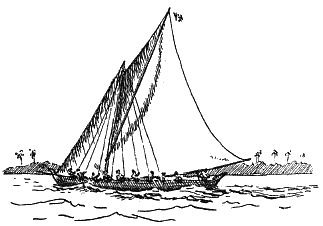 Klinkert
describes this as 'the sail of a small boat which has no
tackle except a brace, but has instead a kind of "sokong"
(= prop)'. This presumably means a spritsail, set up by
its spreet -- no other sail so exactly answering to this
description. In Singapore the koleks have developed into
long boats used a good deal in racing, rigged with large
cloth-made spreet mainsail and stay foresail, and manned
by a large crew of twenty or more, who act as live
ballast out to windward.
Klinkert
describes this as 'the sail of a small boat which has no
tackle except a brace, but has instead a kind of "sokong"
(= prop)'. This presumably means a spritsail, set up by
its spreet -- no other sail so exactly answering to this
description. In Singapore the koleks have developed into
long boats used a good deal in racing, rigged with large
cloth-made spreet mainsail and stay foresail, and manned
by a large crew of twenty or more, who act as live
ballast out to windward.
*1* Dimensions of five-man boat : Length, 24 feet;
beam, 4 feet; depth, 2 feet; freeboard, 1 foot; capacity,
20 pik; length of mast, 24 feet.
In a fresh breeze they stand on the
gunwale, and, holding on to man-ropes leading from the
mast, lean out all their length to windward. These boats
are very slippy with the wind abaft the beam, for, with a
length of 45 feet, they have a beam of not more than 5
feet 6 inches, and a draught of about 2 feet. But they
have no grip for weatherly work. The increase of the
lateral resistance by the introduction of a centre-board
would probably result in enabling these boats to perform
well on a wind in smooth water.
The Lancha or Lanchang is an approach
to a sea-keeping type of vessel. She is rigged with the
ordinary square-headed dipping lugsails, which are of
nearly equal size as in the penjajap. The lofty slender
masts are well stayed, and are stepped in tabernacles of
a kind which is common to the Malays, and both are raked
forward. The sails are made of the screw-palm with cloth
tops, and there are main and peak halyards.
The vessel has a clipper stem, over
which the fore-gallery is built for the anchors; this
also acts as a bumkin or bowsprit for spreading the tack
of the foresail. A comparatively commodious deck cabin
and stern gallery are added over the straight stern-post.
The hull is carvel-built on very European lines, but has
no great depth.
In Selangor it is affirmed that the
Lanchang is a type of boat which was frequently owned by
Malay Rajas on the Sumatran coast, and to this day in
Selangor it is this royal vessel which is dedicated to
the service of the spirits, when the medicine-man invites
them to sail away.
The Lanchang To'Aru (Bandar) is very
similar to the other Lanchang in hull, but is
fore-and-aft rigged with the long topmasts and other
peculiarities mentioned above. To'Aru was one of the
council of four great chiefs of Selangor who in former
days had much power, to whom the election of the Sultan
was intrusted. He was the most powerful of the four, and
took his name from a district called Aru *1* in Sumatra,
from which he came over to settle in Selangor. Bandar was
the site of his home on the Langat River. He appears to
have been a go-ahead seaman and to have realised the
advantages of the European fore-and-aft two-masted rig
even for vessels of strictly Malay build.
The Nadir is a shallow-draught
fishing-boat of the Malacca coast, carvel-built, and with
straight stem and stern posts of European type. *2* The
rig is a single lug. the tack or fore-end of the boom
being made fast well forward of the mast on the weather
bow. The luff is set taut by a spar bowline fitted in a
cringle, the after-end coming to the deck abaft the mast.
There is a peak as well as a main halyard, both in single
parts; the sheet and vang are in one piece, and lead to
the helmsman aft. There are spear-bladed paddles, and the
kadjang, or attap-thatch shelter, used by the crew when
riding to an anchor, is shown rolled up on the
gratings.
*1* Aru is probably the same as the word Aru (also
eru or 'ru) which is the name given to the Casuarina. The
Siamese of the east explain the presence of this
northern-looking tree, which grows in beautiful fringing
groves along the sandy coasts of the Peninsula, by the
legend that it was brought by the drift of the north-east
monsoon, which impinges full upon the coastline, across
the China Sea from Japan. It is a tree of good omen for
it grows on non-malarious spots swept by the clean sea
wind.
*2* Material : Kelidang ; dimensions 24 feet by (xxxx
feet by 3 feet 3 inches; 1 foot freeboard; capacity, 1
koy; crew of 5; length of mast, 30 feet; screw pine-leaf
sail.
The sail is reefed as in the Siamese
Rua Pet by rolling round the main boom to the height
required by help of a wooden pin at the fore-end which is
used as a lever. A rope parrel, as is usual in these
sails, keeps the yard to the mast. Such a boat would be
enormously improved by centre or lee boards.
The Prahu Pelet (qv. Eng. pilot) is a
thorough-going Malay as regards hull, with a low-cut
imitation of a European gig's dipping lug, with the
addition of the usual Malay boom and the vang to the
yard.
RANGUN LIGHTER
These vangs are always necessary owing
to the sails not being of sufficiently stout material to
carry a stout luff-rope, by which the sail can be set up
taut to stand on a wind, as is done in Europe.
The Tongkang Malayu is the Malay
lighter of Singapore. This ketch rig is now much used in
the cargo lighters of Singapore, and is a handy one for a
small crew working about a crowded anchorage liable to
sharp squalls. Mainsail and mizen are set by an Outhaul
along the gaff, and are easily and rapidly taken in by
being brailed to the mast. Many of these boats may be
seen any day working in Singapore roads. There is also a
class of lighter in Singapore rigged with a big
flat-headed lugsail, somewhat like similar lighters at
Rangun. They are big, powerful boats, well suited to
their work. The rig is handy for going alongside ships,
as involving very little gear, but here again the China
lug is often used.
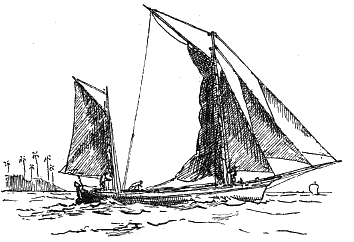

 From
the shelving beaches thrown up by the monsoon it is, of
course, impossible to launch a boat. Hence from October
or November to February or later, according to the
strength of the weather, the whole coast is shut up so
far as local navigation is concerned. An occasional
high-sided Chinese junk will now and then venture along
the coast, but communication in most cases becomes easier
across the Peninsula, and the men of Patani and Singora
find it simpler to cross overland to Kedah to reach the
west coast than to attempt to get out across the
dangerous bars and through the heavy sea raging on the
eastern coast.
From
the shelving beaches thrown up by the monsoon it is, of
course, impossible to launch a boat. Hence from October
or November to February or later, according to the
strength of the weather, the whole coast is shut up so
far as local navigation is concerned. An occasional
high-sided Chinese junk will now and then venture along
the coast, but communication in most cases becomes easier
across the Peninsula, and the men of Patani and Singora
find it simpler to cross overland to Kedah to reach the
west coast than to attempt to get out across the
dangerous bars and through the heavy sea raging on the
eastern coast.
 This
essentially modern product of Western Europe he uses not
only in the large traders already referred to, but also
in the kolek, or 'sea-canoe' of Singapore, in which also
the old Malay lug has been altogether discarded,
especially for racing purposes, in favour of the
spritsail. The staysail is recognised as the most
convenient form of head-sail to prevent excessive
griping, and does not involve the disadvantages of the
weight of a mast right in the eyes of the
boat.
This
essentially modern product of Western Europe he uses not
only in the large traders already referred to, but also
in the kolek, or 'sea-canoe' of Singapore, in which also
the old Malay lug has been altogether discarded,
especially for racing purposes, in favour of the
spritsail. The staysail is recognised as the most
convenient form of head-sail to prevent excessive
griping, and does not involve the disadvantages of the
weight of a mast right in the eyes of the
boat. A
large number of boats, as might be expected, are
distinguished by the use for which they are built, e.g.
the 'boat for going up-stream,' *5* and various types of
fishing boat ; *6* others are of purely local
significance, e.g. 'banting' (an Achinese type), while
several appear to be derived from European names, e.g.
'skonar' (schooner), and 'pinis' (pinnace), and perhaps
'kichi' (ketch), 'skuchi' (scotchy), and 'katar' '
(cutter).
A
large number of boats, as might be expected, are
distinguished by the use for which they are built, e.g.
the 'boat for going up-stream,' *5* and various types of
fishing boat ; *6* others are of purely local
significance, e.g. 'banting' (an Achinese type), while
several appear to be derived from European names, e.g.
'skonar' (schooner), and 'pinis' (pinnace), and perhaps
'kichi' (ketch), 'skuchi' (scotchy), and 'katar' '
(cutter).
 Klinkert
describes this as 'the sail of a small boat which has no
tackle except a brace, but has instead a kind of "sokong"
(= prop)'. This presumably means a spritsail, set up by
its spreet -- no other sail so exactly answering to this
description. In Singapore the koleks have developed into
long boats used a good deal in racing, rigged with large
cloth-made spreet mainsail and stay foresail, and manned
by a large crew of twenty or more, who act as live
ballast out to windward.
Klinkert
describes this as 'the sail of a small boat which has no
tackle except a brace, but has instead a kind of "sokong"
(= prop)'. This presumably means a spritsail, set up by
its spreet -- no other sail so exactly answering to this
description. In Singapore the koleks have developed into
long boats used a good deal in racing, rigged with large
cloth-made spreet mainsail and stay foresail, and manned
by a large crew of twenty or more, who act as live
ballast out to windward.